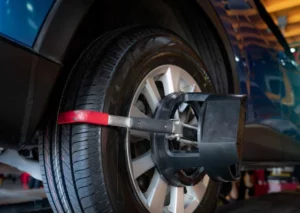Finding Balance: The Importance of Wheel Balancing

Your vehicle’s wheels may seem like simple components, but they play a critical role in your driving experience. One often-overlooked aspect of wheel maintenance is balancing. Properly balanced wheels are essential for a smooth and safe ride. In this blog post, we’ll delve into the world of wheel balancing, exploring its significance, how it works, signs of imbalance, the benefits of proper balancing, maintenance tips, and why professional auto service is crucial to keep your wheels rolling smoothly.
The Significance of Wheel Balancing
Wheel balancing is significant for several reasons:
- Ride Comfort:
Balanced wheels prevent vibrations and provide a smoother ride. - Tire Longevity:
Balancing extends the life of your tires by preventing uneven wear. - Handling:
Balanced wheels contribute to improved vehicle stability and handling. - Safety:
Reduced vibration ensures better control and reduces driver fatigue.
How Wheel Balancing Works
Wheel balancing involves adding or removing weight to balance the wheel and tire assembly. It typically includes these steps:
- Mounting
The wheel and tire are mounted on a balancing machine. - Measurement
The machine measures imbalances in the assembly. - Weight Placement
Counterweights are added to balance the wheel.
Signs of Wheel Imbalance
Common signs of wheel imbalance include:
- Vibration
You feel vibrations in the steering wheel or through the vehicle’s floor. - Uneven Tire Wear
Tires may show signs of uneven wear patterns. - Steering Wobble
The steering wheel wobbles at certain speeds. - Reduced Fuel Efficiency
Imbalanced wheels can lead to decreased fuel efficiency.
Benefits of Proper Wheel Balancing
Proper wheel balancing offers several benefits:
- Ride Comfort
A smoother, vibration-free ride enhances comfort. - Tire Longevity
Balanced wheels prevent premature tire wear. - Improved Handling
Balanced wheels contribute to better vehicle control. - Safety
Reduced vibration reduces the risk of accidents due to loss of control.
Maintenance Tips for Wheel Balancing
To ensure your vehicle’s wheels remain balanced, consider these maintenance tips:
- Regular Inspections
Include wheel balancing checks during routine maintenance. - Balance After Tire Changes
Balance wheels when installing new tires or after tire rotation. - Pothole Avoidance
Drive cautiously to minimize the risk of imbalance from road hazards.
Why Professional Auto Service Matters
Professional auto service is essential for wheel balancing because:
- Expertise
Skilled technicians understand the nuances of wheel balancing. - Precision Equipment
Auto shops use specialized balancing machines for accuracy. - Quality Balancing
Reputable providers ensure your wheels are balanced to perfection. - Safety
Proper wheel balancing enhances ride comfort and control. - Preventative Care
Professionals can detect imbalance issues before they cause significant problems.
Wheel balancing isn’t just about comfort; it’s about safety, tire longevity, and vehicle performance. Understanding its significance, recognizing signs of imbalance, and adhering to maintenance schedules are essential for responsible car ownership. However, entrusting wheel balancing to professional auto service providers is the key to ensuring your wheels stay in perfect harmony, allowing you to enjoy a vibration-free, smooth, and safe ride for miles to come.











